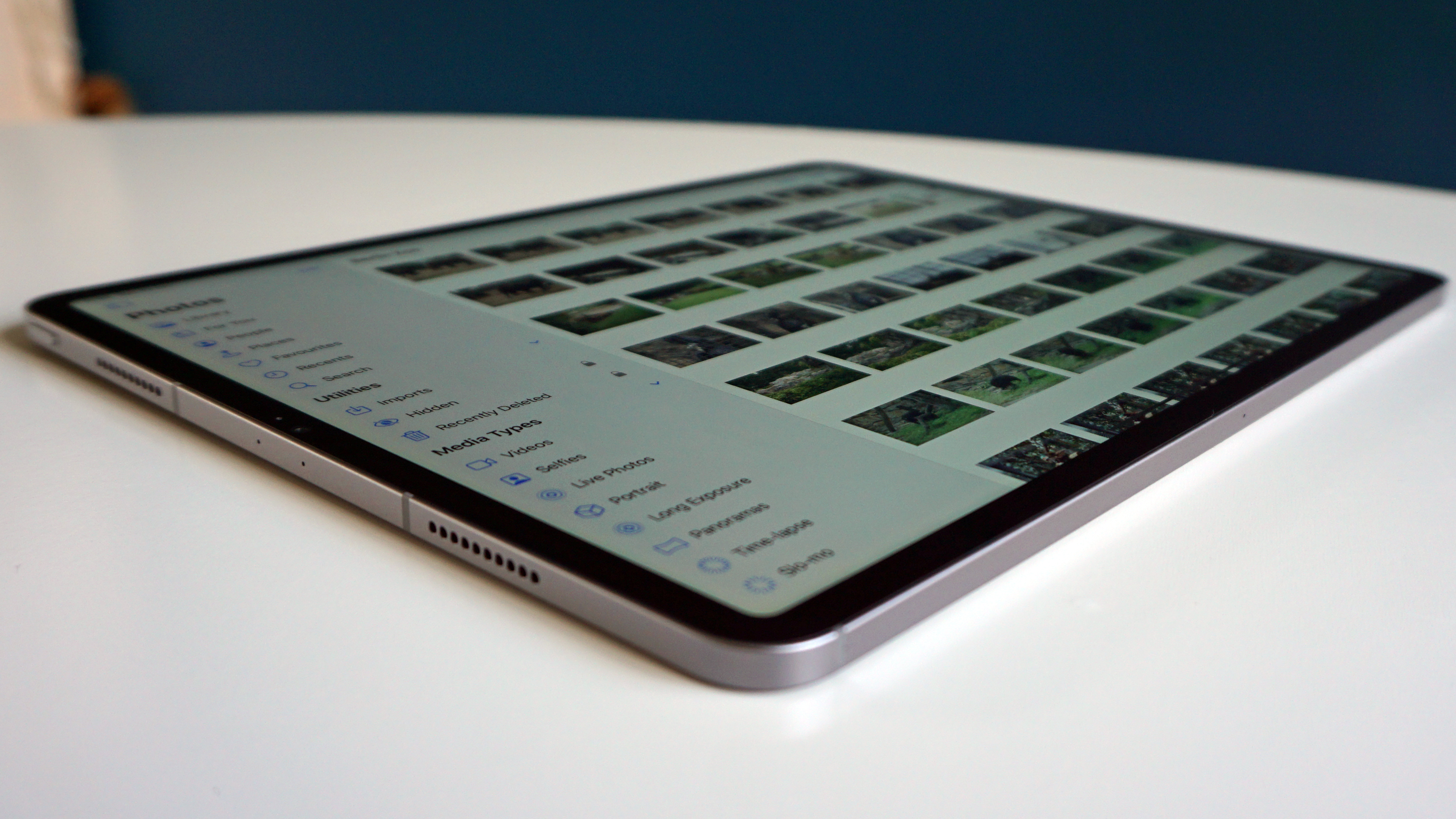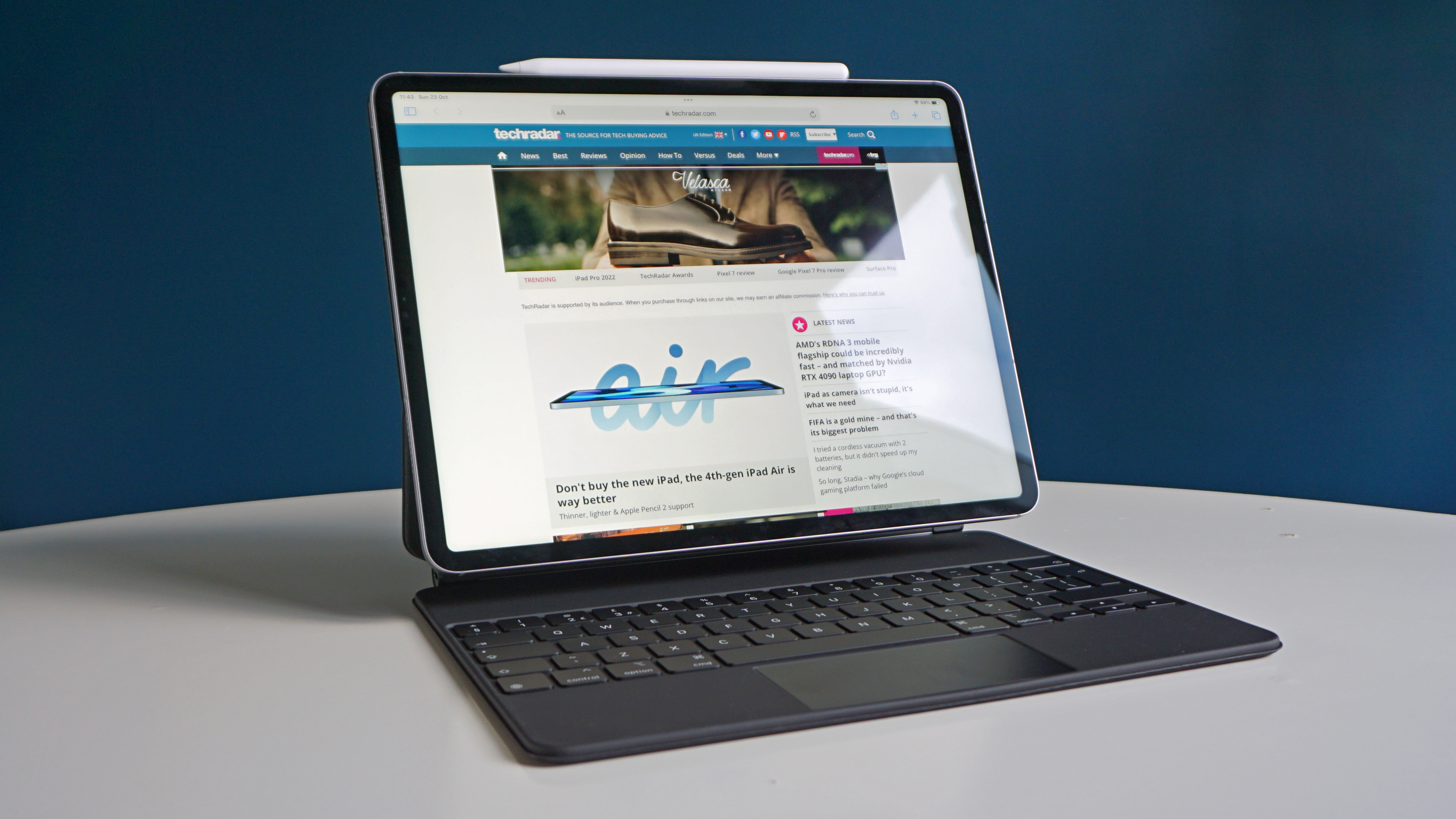iPad Pro (2024) vs iPad Pro (2022): the key differences

There was an almost-two-year gap between the iPad Pro (2022) and the iPad Pro (2024), so you could reasonably expect the new tablet to be a massive upgrade, and in many ways, it is.
The iPad Pro (2024) has a better screen, more power, and various other upgrades, but there’s plenty that has remained similar to the 2022 model, and – surprisingly – there's even ways in which the older device has it beat.
Below, you’ll find a full comparison of every key aspect of these two tablets, from their designs and displays to their cameras, batteries, and beyond, so you can get a clearer idea of which – if either – tablet you should buy, and whether it’s worth upgrading from the iPad Pro (2022) to the iPad Pro (2024).
In the case of the iPad Pro (2024), the below information is based on the specs list and our hands-on iPad Pro 13-inch (2024) review. For the older model, we have both specs lists and a full iPad Pro 12.9-inch (2022) review to go on.
iPad Pro (2024) vs iPad Pro (2022): specs comparison
Before we dive into the similarities and differences between these two tablets, you can see a brief overview of how their specs compare in the chart below.
| iPad Pro 11-inch (2024) | iPad Pro 13-inch (2024) | iPad Pro 11-inch (2022) | iPad Pro 12.9-inch (2022) | |
|---|---|---|---|---|
| Display: | 11-inch OLED | 13-inch OLED | 11-inch LCD | 12.9-inch mini-LED |
| Resolution: | 1668 x 2420 pixels | 2064 x 2752 pixels | 1668 x 2388 pixels | 2048 x 2732 pixels |
| Refresh rate: | Adaptive 10-120Hz | Adaptive 10-120Hz | Adaptive 24-120Hz | Adaptive 24-120Hz |
| Chipset: | M4 | M4 | M2 | M2 |
| Rear cameras: | 12MP wide | 12MP wide | 12MP wide, 10MP ultra-wide | 12MP wide, 10MP ultra-wide |
| Front camera: | 12MP ultra-wide | 12MP ultra-wide | 12MP ultra-wide | 12MP ultra-wide |
| RAM: | 8GB, 16GB | 8GB, 16GB | 8GB, 16GB | 8GB, 16GB |
| Storage: | 256GB, 512GB, 1TB, 2TB | 256GB, 512GB, 1TB, 2TB | 128GB, 256GB, 512GB, 1TB, 2TB | 128GB, 256GB, 512GB, 1TB, 2TB |
| Battery: | Up to 10 hours | Up to 10 hours | Up to 10 hours | Up to 10 hours |
iPad Pro (2024) vs iPad Pro (2022): price and availability

The iPad Pro (2024) was announced on May 7, 2024, and it’s available to pre-order now, with the device shipping on May 15.
The iPad Pro 11-inch (2024) starts at $999 / £999 / AU$1,699, which gets you a 256GB Wi-Fi model. It tops out at $2,299 / £2,299 / AU$3,629, which gets you a 2TB Wi-Fi and cellular model with nano-texture glass (an optional extra that’s only available with 1TB and 2TB models).
Sign up for breaking news, reviews, opinion, top tech deals, and more.
The larger iPad Pro 13-inch (2024) starts at $1,299 / £1,299 / AU$2,199, rising to $2,599 / £2,599 / AU$4,479 at the top end – in both cases in the same configurations as the iPad Pro 11-inch model.
As for the iPad Pro (2022), that's now been discontinued (though some third-party stores will still stock it for a while). The official price starts (or started) at $799 / £899 / AU$1,399 for an 11-inch Wi-Fi model with 128GB of storage.
The iPad Pro 12.9-inch (2022) starts at $1,099 / £1,249 / AU$1,899 (again for a 128GB Wi-Fi model), and it tops out at $2,399 / £2,679 / AU$4,099 (for a 2TB cellular model – though there’s no nano-texture glass available here).
So, the iPad Pro (2024)’s starting price is $200 / £100 / AU$300 higher than the iPad Pro (2022)’s, and it tops out at a higher level too. Note, however, that you get twice as much storage in the base 2024 model than the 2022 one, so that goes some way to justifying the higher starting price.
For a more comprehensive breakdown of the latest iPad prices, head over to our new iPad prices guide.
iPad Pro (2024) vs iPad Pro (2022): design and display

The iPad Pro (2024) has a broadly similar design to the iPad Pro (2022). At a glance, you might not be able to tell much of a difference, other than the colors, with the 2024 model coming in a choice of Silver or Space Black, while the 2022 one comes in Silver or Space Gray.
The position of the front-facing camera also differs; it's on the long edge of the iPad Pro (2024) and the shorter top edge of the iPad Pro (2022). Otherwise, though, they look a lot alike, and are both clad in aluminum.
However, the iPad Pro (2024) is a whole lot thinner and lighter than the previous model. The iPad Pro 11-inch (2024) is 249.7 x 177.5 x 5.3mm and weighs 444g, while the iPad Pro 11-inch (2022) is 247.6 x 178.5 x 5.9mm and weighs 466g.
The difference is even more pronounced on the larger models, with the iPad Pro 13-inch (2024) being 281.6 x 215.5 x 5.1mm and weighing 579g, while the iPad Pro 12.9-inch (2022) is 280.6 x 214.9 x 6.4mm and weighs 682g. It's quite an achievement, with our hands-on iPad Pro 13-inch (2024) review describing the new tablet as "impossibly thin."

While some of the design differences can only be identified by holding Apple's new iPads, the difference in displays should be more immediately obvious. The 2024 models have an OLED screen, while the iPad Pro 11-inch (2022) has an IPS LCD one and the 12.9-inch iPad Pro (2022) has a mini-LED one (which is still a type of LCD).
OLED offers better contrast, deeper blacks, and while it can be less bright, Apple’s implementation isn’t, with all four tablets topping out at 1,600 nits of brightness (for HDR). In fact, the iPad Pro (2024) has the 2022 models beat for SDR (standard dynamic range) brightness, topping out at 1,000 nits rather than 600 nits.
And while both the 2022 and 2024 models have a 120Hz refresh rate, the iPad Pro (2024) can drop as low as 10Hz when a speedy refresh isn’t needed, while the iPad Pro (2022) can only drop to 24Hz.
In other ways, though, they’re largely similar, coming in at roughly the same display sizes (though the new 13-inch model is marginally larger than its 12.9-inch predecessor), and having roughly the same number of pixels per inch – specifically, 264 for the 2024 models and 265 for the 2022 ones.
iPad Pro (2024) vs iPad Pro (2022): cameras

One area where the iPad Pro (2022) might actually have an advantage over Apple's newer iPad is the cameras. While both generations have a 12MP f/1.8 main camera, that’s joined by a 10MP f/2.4 ultra-wide on the iPad Pro (2022), while the iPad Pro (2024) just has the one rear camera.
Both generations have a LiDAR scanner for judging depth though, and the iPad Pro (2024) does have an upgraded flash, which Apple has dubbed an “adaptive True Tone flash”. This can leverage AI to remove shadows when scanning documents, by stitching multiple photos together.
Both generations of iPad Pro also have a 12MP f/2.4 ultra-wide front-facing camera, but while this is on the top edge of the iPad Pro (2022), it’s on one of the long edges of the iPad Pro (2024), making it better suited for landscape use here – which is the orientation typically used for video calls on an iPad, so it’s arguably a better position.
iPad Pro (2024) vs iPad Pro (2022): performance and software

While the iPad Pro (2022) might have an edge when it comes to the camera, the iPad Pro (2024) certainly wins on the performance front, as it has a new M4 chipset, which delivers up to 1.5x faster CPU performance than the M2 chipset in the iPad Pro (2022). The M4 can also deliver the same performance as the M2 at half the power, and it’s paired with Apple’s most powerful Neural Engine ever.
All that said, the M2 in the iPad Pro (2022) remains a very powerful chipset, with our review saying it's "almost impossible to make it stutter." So, neither of these tablets should feel lacking on that front, and they both also come with either 8GB or 16GB of RAM (depending on how much storage you choose).
For software, both generations of tablet run iPadOS 17.4, though in the case of the iPad Pro (2024), it runs that out of the box, while the iPad Pro (2022) can be updated to this latest version of the software. That’s only relevant because it means the iPad Pro (2022) has of course already had some software updates, and will probably stop getting updated before the iPad Pro (2024).
iPad Pro (2024) vs iPad Pro (2022): battery

Apple never reveals battery capacities, but the company has said that you can get up to ten hours of surfing the web on Wi‑Fi or watching video, or up to nine hours of surfing the web using mobile data. That’s true of both generations of tablet in both sizes, so battery life should be similar no matter which model you choose.
For what it’s worth, while Apple hasn’t revealed battery capacities, we do know them for the 2022 models thanks to teardowns. The iPad Pro 11-inch (2022) has a 7,538mAh battery, and the iPad Pro 12.9-inch (2022) has a 10,758mAh one.
If anything, we’d guess the batteries in the iPad Pro (2024) models are smaller, given that these tablets are slimmer and lighter – but Apple has probably achieved similar life through a more efficient chipset and display.
All of these tablets charge via USB-C – there’s no wireless charging.
iPad Pro (2024) vs iPad Pro (2022): verdict
The iPad Pro (2024) is a big upgrade on the iPad Pro (2022) in terms of its screen and power. The move to OLED has been long-awaited, and should make a noticeable difference in display quality, and the M4 chipset is dramatically more powerful than the M2 in the iPad Pro (2022).
The new model is also slimmer and lighter than its predecessor, has a repositioned – for the better – front-facing camera, a higher starting storage capacity, and an improved camera flash.
However, it also costs more, has one less camera, and the same advertised battery life. And while its screen and power are upgrades, the iPad Pro (2022) already excelled on both of those fronts anyway.
So, if you already have an iPad Pro (2022), then you might want to think twice about upgrading, though you’re sure to notice the difference if you do. If you’re rocking an older or lesser iPad, then the iPad Pro (2024) should make for a vast improvement – though you might want to wait for our full review, just to be sure it’s as good as it seems on paper.
You might also like
- Hands-on iPad Pro 13-inch (2024) review: the impossibly thin king of iPads
- Hands on: iPad Air 13-inch (2024) review: you no longer need to go Pro
- Apple iPad event 2024 – 9 things we learned from the Let Loose event
James is a freelance phones, tablets and wearables writer and sub-editor at TechRadar. He has a love for everything ‘smart’, from watches to lights, and can often be found arguing with AI assistants or drowning in the latest apps. James also contributes to 3G.co.uk, 4G.co.uk and 5G.co.uk and has written for T3, Digital Camera World, Clarity Media and others, with work on the web, in print and on TV.